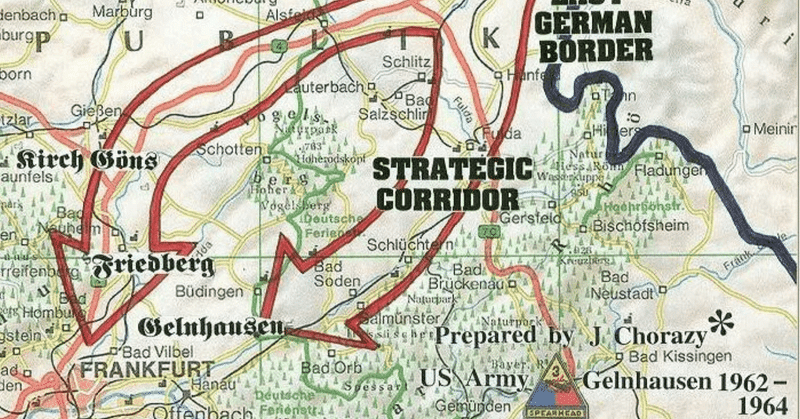
【SNS投稿和訳】冷戦後期のソ連軍ドクトリン解説(John Helin氏)
The discourse on Ukraine's counter-offensive often oversimplifies Soviet doctrine as rigid mass warfare and NATO- as flexible maneuver warfare.
— John Helin (@J_JHelin) November 7, 2023
The truth is far more nuanced, and needed for future discussions.
Thus: Soviet tactical and operational doctrine, a thread.
1/ pic.twitter.com/ueAsddwflj
この記事は、上記のX連続投稿(日本時間2023年11月7日19:20投稿)の日本語訳です。投稿者のジョン・ヘリン氏は、フィンランドのOSINTチームであるBlack Bird Groupのメンバーで、ウクライナでの戦争の理解を深める意図で、ソ連の軍事ドクトリンの解説をしています。なお、本記事中の画像は、ジョン・ヘリン氏の投稿から転載して使用しています。
冷戦後期のソ連軍ドクトリン
日本語訳
ウクライナの反転攻勢を巡る議論のなかで、ソヴィエト式ドクトリンは融通のきかない大規模戦闘として、一方でNATO式ドクトリンは柔軟な機動戦として、しばしば過度に単純化されて語られている。
だが、実情はかなり複雑で繊細なものであって、それを知ることは今後の議論のために必要だ。
それゆえ、このスレッドではソヴィエトの戦術・作戦ドクトリンを扱っていく。
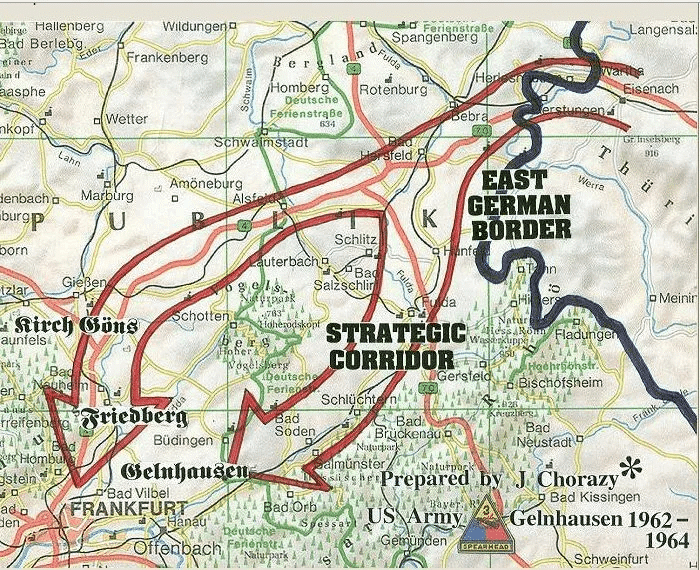
扱う事項を分かりやすくするため、ソ連軍の作戦・戦術ドクトリンのうち冷戦後期のものに絞って説明していこうと考えている。それは、この時期が、私たちとウクライナにとって、最も関連ある時期だからだ。
ソ連軍の作戦は軍と正面軍のレベルで実施される。師団とそれ以下の編制単位は、戦術の領域に属することになっている。
小規模部隊の交戦で勝利をおさめられるかどうかは、諸兵科連合、火力、機動によって左右された。地上軍と空軍、戦闘部隊と支援部隊は、部分の合計以上の効果を発揮するために、密接に協力して行動する必要があった。
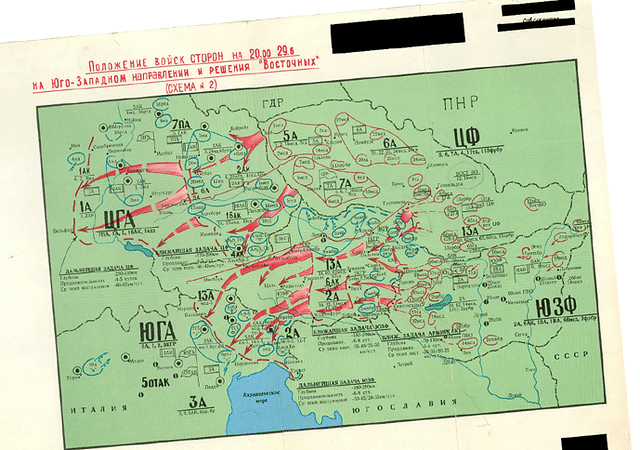
ソ連軍にとっての最優先事項は、攻勢行動だ。そして、とりわけ強調していたのが、完全な機械化と機動力による戦力と火力の集中である。ソ連軍の理想的な戦略は強力な第一撃であって、その目的は敵軍の作戦的縦深を貫通し、敵側戦力の組織を壊すことにあった。
第一に火力が伴う機動を。火力と機動は等しい。
あらゆるソ連軍攻勢は、敵側縦深全体に向けた、長く続く大規模砲撃で始まる予定であった。砲兵に加え、ミサイル部隊と航空戦力が、正面軍と軍の司令官に直属することになっていた。

戦術単位部隊の指揮官は、自部隊にもともと組み込まれている火力を直接指揮できたものの、火力支援のほとんどは極端な集中運用のもとにあり、作戦開始時の最も重要な数時間、火力効果が最大化されるようになっていた。だが一方で、作戦が続いていくにつれ、このような集中運用は、連携の問題に関わるリスクを負うことになった。
空軍とミサイル部隊は、敵軍の指揮・支援要素を打撃するために用いられることになっていた。砲兵・ミサイル・航空の各戦力の連携があるにも関わらず、ソ連軍は自軍が航空優勢を獲得できると常に想定していたわけではなかった。ソ連軍は支配権が競合する空域での作戦遂行を想定しており、そのため対空能力に依存していた。

機動戦力を集中させる必要が生じたならば、それは迅速に行わなければならない。そして、任務達成後、できるだけすみやかに戦力を分散させねばならない。
長距離火力の危険性を、ソ連軍は正確に理解していた。本質的に重要とされたのは、分散と機動だった。ソ連軍は行軍からの攻撃を重視していた。
行軍からの攻撃によって、ソ連軍は段階的に地上戦力を戦闘に振り向けることができ、また、必要に応じて突破のために戦力を大規模に集結させることもできるとされていた。ソ連軍はまた、敵軍が効果的な対応できるようになる前に、戦術レベルと作戦レベルで突破を迅速に活かすことができた。
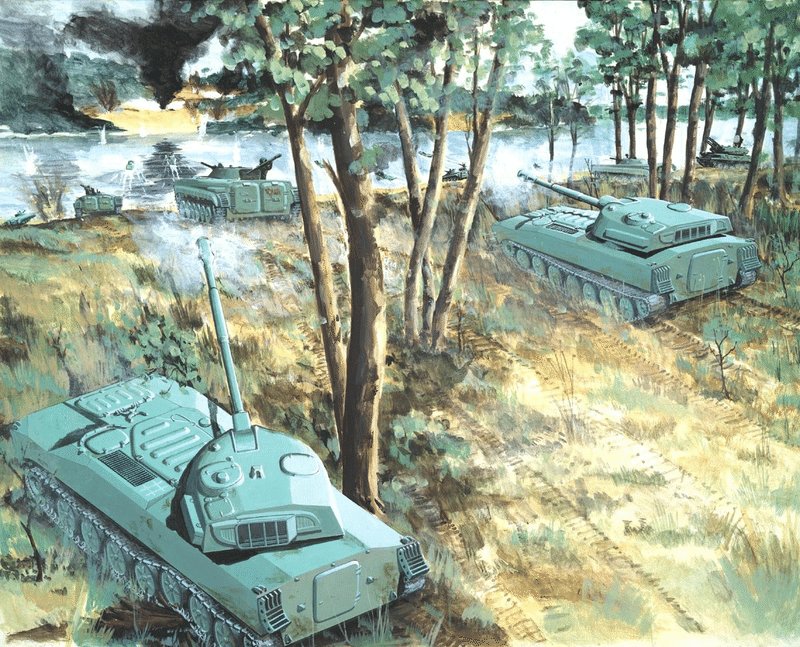
西へ向かって進む戦車軍団という古典的なイメージが正確でないというわけではない。ソ連軍は戦術レベルの交戦のために、比較的分散した戦力を集結させる意図をもっていた。事前の戦闘訓練に沿って行軍隊形から迅速に展開することが、必要不可欠なことだった。
戦闘訓練は戦術的に制約される面が多かったけれども、ソ連軍の作戦指揮官は、その行動の自由を比較的享受することができた。作戦指揮官にとっての重要な目標は、敵側縦深へと貫くように進み、敵側機動戦力及び支援戦力を孤立化させていく、もしくは包囲していくことにあった。
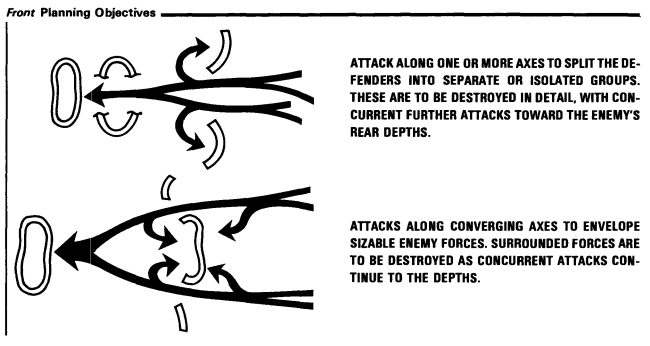
機動部隊は敵防衛網の最も弱い部分を攻撃すべきだ。必要ならば、核火力もしくは非核火力を用いて脆弱点や穴をつくり出せ。そして、敵の守りの堅い地点を迂回し、敵後方奥深くを攻撃せよ。
ソ連軍の攻勢は、抵抗が最弱のルートを探すことを試みようとした。
前方偵察部隊は敵防衛線の最弱地点を探ることを試み、それと並行して、機械化戦力が防衛陣地を迂回移動するのに利用可能な経路を探そうともする。その後、ソ連軍は前線全体に圧力をかけるべく、一度に複数軸で攻撃を仕掛ける。
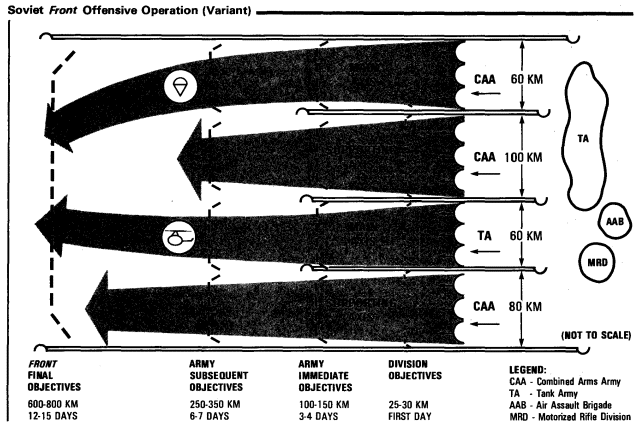
第一梯団は通常、自動車化狙撃部隊で構成されているが、この第一梯団の任務は敵前線に間隙をつくることにあった。そののち、通常は戦車部隊である第二梯団が突破を活かすために投じられ、敵側の作戦縦深内へと深く進撃する予定になっていた。
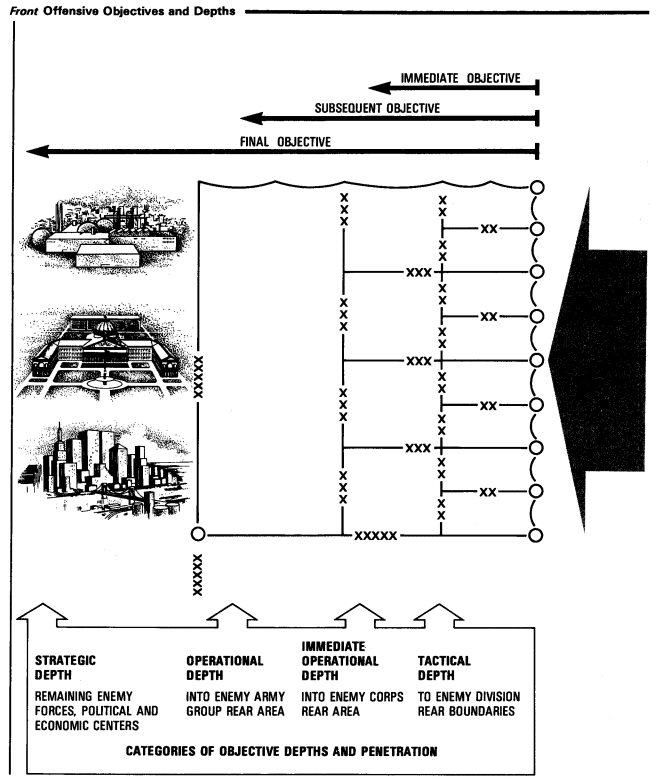
ソ連軍第一梯団部隊が防衛網を崩せなかった場合、その部隊は敵軍をその場に釘づけにする方向へと行動を変換する。そして、作戦指揮官は第二梯団をより成功が見込める攻勢軸に振り向けることになる。
迂回した陣地群は、第二梯団の通過後に潰していくことになる。
このようにソ連軍の作戦はかなり流動的に進んでいく。まるで水が岩の周囲を流れていくようなものだ。高い機動性、比較的分散した、梯形に構成されるという特徴をもつ戦力によって、ソ連軍の作戦指揮官は戦力・火力の集結地点を、比較的迅速に変更できた。
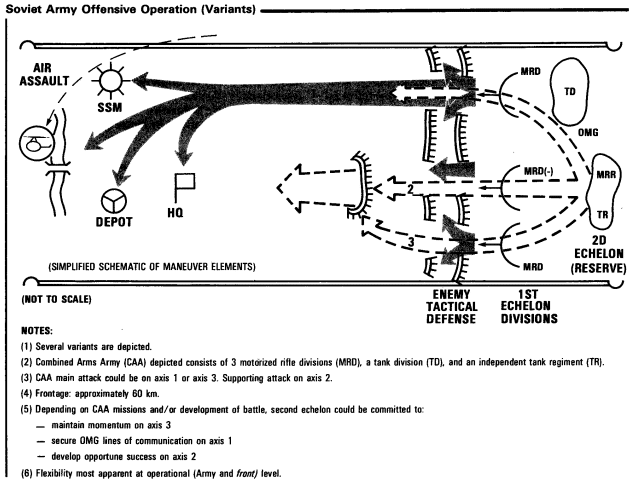
これまでみてきたような流動的な機械化部隊による作戦行動を確実に成功させるため、ソ連軍は作戦初期段階で「前方投入部隊」を用いて、緊要地形の確保と敵側作戦行動の妨害を行うことになっていた。空挺戦力の投入は、橋梁の占領、もしくは敵指揮施設の無力化を可能にするものだった。
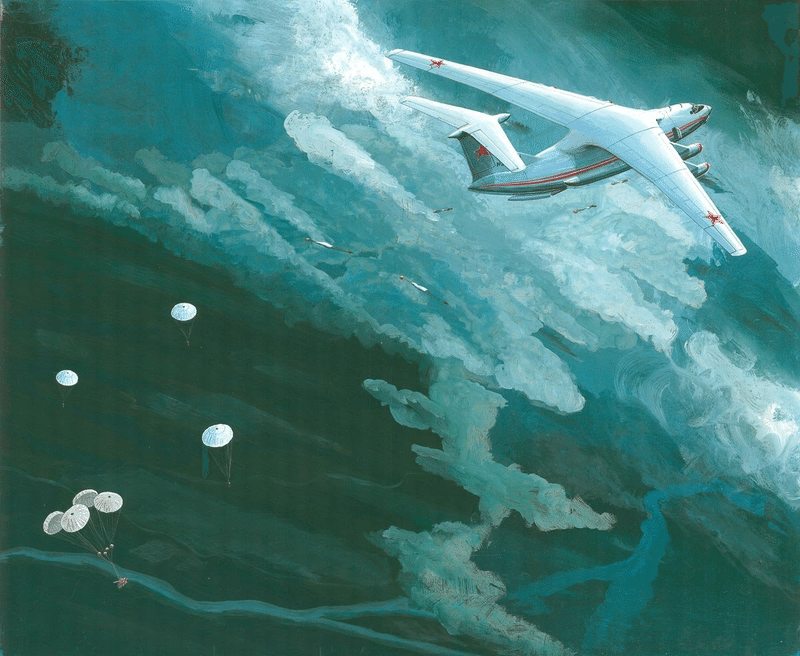
敵を欺け。予想外のタイミングで、予想外の方向から攻撃せよ。地形と天候を自軍に有利となるように使え。
「マスキロフカ[欺瞞]」について、多くのことが語られてきたかもしれない。だが、欺瞞はソ連軍作戦にとって必要不可欠な要素だ。主正面を秘匿しておくことは、成功の基本だ。
あらゆる作戦にとって、指揮の統一、唯一の司令官の存在が必要だ。(…)計画に書かれている文言と計画の意図を遵守せよ。計画が失敗した場合、任務を達成するためにイニシアティヴを発揮せよ。
すでに述べたように、ソ連軍の指揮構造は、NATO軍のそれに比べて、かなり中央集権化されていることが多かった。
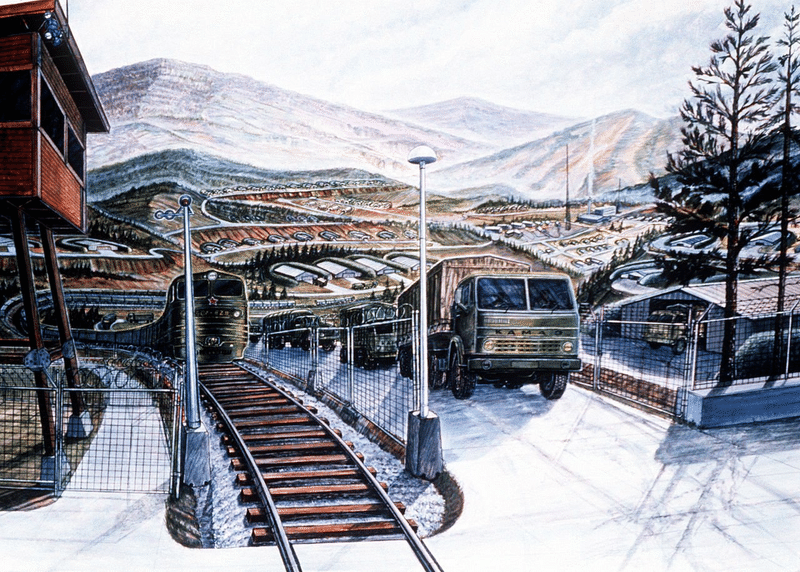
ソ連軍は実際のところイニシアティヴの推奨を試みていたのだが、上の引用で分かるように、計画の意図と文言に従うことが、しばしば強調されていた。このことは戦闘訓練で強調されている。とりわけ下級指揮官は選択肢が限られた指針しか持っておらず、完全な行動の自由は持ち得なかった。
その一方で、戦闘訓練とドクトリン遵守的アプローチを重視することで、理論上、ソ連軍は戦場でのすばやい決心が容易にでき、進行中の新たな戦術状況に合わせることが容易にできることになっていた。
死傷者が多く出る傾向はあったが、このような方法をとることで、攻勢の勢いを保持できるとされた。
語ることはまだまだ多くあるが、そろそろまとめていこう。
ソ連軍は高機動力と諸兵科連合戦闘を重視していた。NATOドクトリンとの一番の相違は、戦争における作戦レベルの強調と、戦術レベルでのアプローチの相違だった。

ドクトリン・計画・戦闘訓練に従うことが、個々の指揮官が自発的に行動することよりも重要視された。このことに加えて、積極的な攻勢行動を、それとともに砲火力の規模と集中を、ソ連軍は西側陸軍以上に重視した。
語るべき内容はまだまだあるが、ウクライナの反転攻勢とその軍隊について今後、議論を行うには、ここで説明した内容で十分である。
私たちが反転攻勢の詳細な分析を始めるときに、Black Bird Groupとともにこのスレッドに立ち返ることになるだろう。
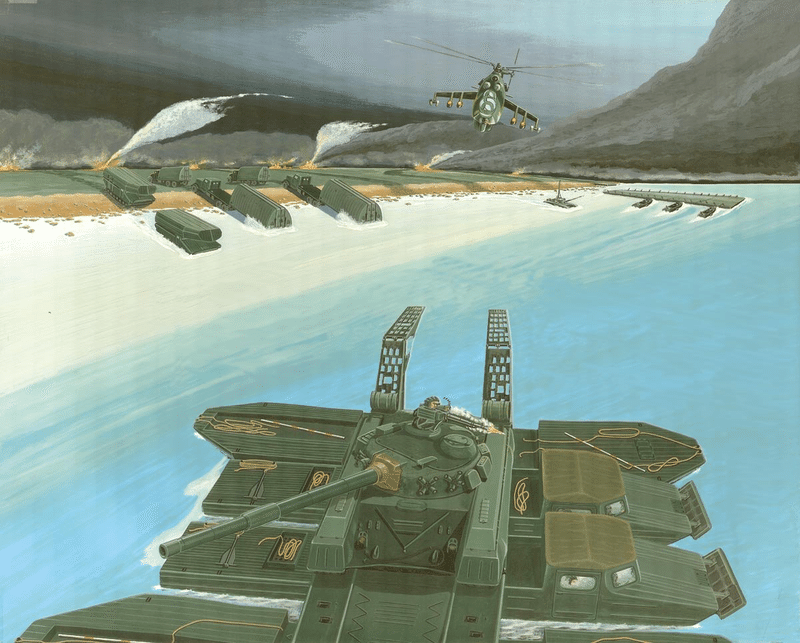
附記
主な情報源と引用元:
FM 100-2-1 "THE SOVIET ARMY: Operations and Tactics", US Army 1984
Eisenstadt & Pollack: "Armies of Snow and Armies of Sand: The Impact of Soviet Military Doctrine on Arab Militaries", Middle East Journal, 55/4, 2001, pg. 549-578
ソ連型陸軍との戦闘に特化したフィンランド国防軍将校訓練
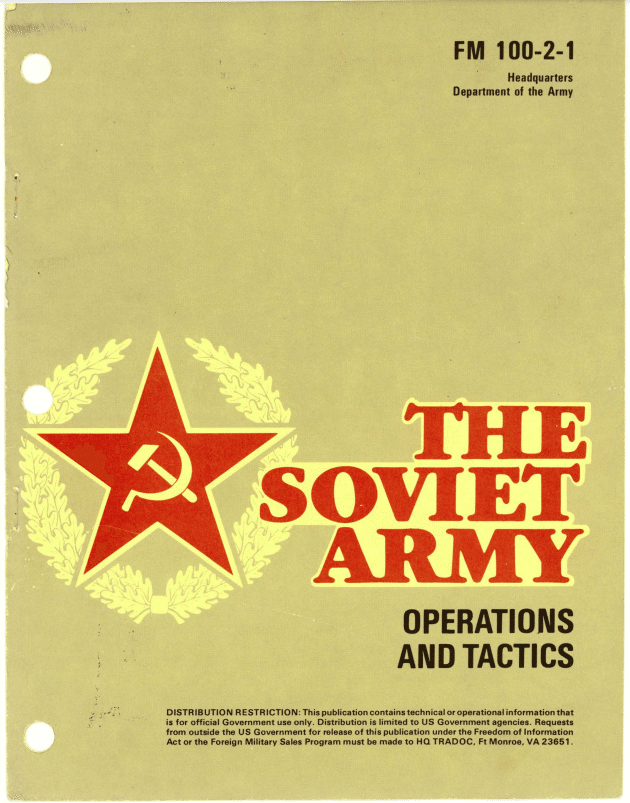
ソ連型戦争様式に関して、私が持ちうる以上の優れた学術的見識を持つ人々や専門家と長時間の話し合いができ、それらの人々からフィードバックしてもらえたことに関して、とても感謝している。
ドムという名の男には特に。
投稿原文(英文)
The discourse on Ukraine's counter-offensive often oversimplifies Soviet doctrine as rigid mass warfare and NATO- as flexible maneuver warfare.
The truth is far more nuanced, and needed for future discussions.
Thus: Soviet tactical and operational doctrine, a thread.
To keep things simple, I'll stick to the operational and tactical elements of Soviet doctrine during the late Cold War—the most relevant period for us and Ukraine.
Soviet operations were conducted by Armies and Fronts. Division and below would belong in the realm of tactics.
"Success in small-unit engagements was dependent on combined arms integration, firepower, and maneuver. Moscow taught that ground and air forces, and combat and support units had to work closely together to achieve an effect that was greater than the sum of their parts"
Soviets prioritized offensive actions, emphasizing concentration of force and firepower through mobility and full mechanization. Their ideal strategy was a strong, early blow to penetrate the enemy's operational depth and disorganize enemy forces.
"Maneuver first with firepower. Firepower is maneuver"
Any Soviet offensive would start with long-lasting massed fires throughout the enemy depth. In addition to artillery, missile troops and air force assets, would be subordinated directly to the Front and Army commanders.
Tactical leaders had direct control over their organic fires, but most fire support was highly centralized to maximise effectiveness during the critical early hours of any operation. However, as operations continued this centralization risked coordination problems.
Air and missile forces would be used to hit enemy command and support elements. Despite this coordination of artillery-, missile- and air forces, the Soviets did not always expect to have air superiority. They expected to operate in contested airspace and relied on anti-air.
"If maneuver forces must be massed, do so rapidly. Disperse them as soon as possible after the task has been achieved."
The Soviets were acutely aware of the danger of long-range fires. Dispersal and mobility were essential. The Soviets focused on attacking from the move.
Attacking from the move would both let the Soviets apply ground forces gradually to a battle and bring together a larger force for a breakthrough when needed. They could also quickly exploit tactical and operational breakthroughs before the enemy could effectively react.
That's not to say that the classic image of armored flotillas heading westwards is not accurate. The Soviets would mass relatively dispersed forces together for tactical engagements. Fast deployment from march formation to rehearsed battle drills was essential.
While the battle drills were often tactically somewhat limited, Soviet operational commanders enjoyed relative freedom of action. The most important objective for them would be penetrating into enemy depth, and isolating, or surrounding enemy maneuver- and support forces.
"Maneuver forces should attack the weakest points in enemy defenses. If necessary, create weak points or holes with nuclear or nonnuclear fires. Bypass enemy strongpoints to strike deeply into his rear."
Soviet offensives would attempt to find the path of least resistance.
Forward recon elements would attempt to find the weakest points in the enemy line, as well as any useable routes for mechanized forces to go around the defensive positions. The Soviets would then attack on multiple axes at once to exert pressure over the whole frontline.
The job of the first echelon, generally made up of motor rifle formations, was to create a gap in the enemy frontline. Then the second echelon, usually tank formations, would be thrown in to exploit the breakthrough and advance deep into the enemy's operational depth.
To ensure the success of these fluid mechanized operations, the Soviets would use "forward detachments" in the early phases of the operation to capture key terrain and disrupt enemy operations. Air assault forces could capture bridges or neutralize enemy command posts.
"Deceive the enemy. Attack from an unexpected direction at an unexpected time. Use terrain and weather to your advantage"
We may talk too much about "Maskirovka", but deception was essential to Soviet operations. Keeping the main direction a secret was essential for success
"There must be unity of command, a single commander for any operation... Adhere to the spirit and letter of a plan. If the plan fails, use initiative to accomplish the mission."
As said before, the Soviet command was often rather centralized compared to NATO armies.
The Soviets did attempt to encourage initiative, but as we can see from the quote above, following the spirit and letter of the plan was often emphasized. The battle drills underline this: the junior leaders especially had a limited playbook, not full freedom of action.
On the other hand, the focus on battle drills and doctrinal approaches meant that, in theory, the Soviets could easily make snap decisions on the battlefield and adjust to new tactical situations on the go.
Although casualty-prone, this would retain offensive momentum.
There's a lot more we could talk about here, but it's time to wrap it up.
The Soviets focused on mobile maneuver and combined arms warfare. The major difference to NATO doctrine was the emphasis on the operational level of war and a different approach to the tactical layer.
Adherence to doctrine, plans and battle drills was more important than every individual commander's freedom of action. In addition to this, the Soviets emphasized aggressive offensive action, as well as the volume and concentration of fires more than Western armies did.
There'd be more to talk about, but the things discussed here are enough for future discourse about the Ukrainian counteroffensive and armed forces.
We'll be coming back to this thread with @Black_BirdGroup as we start analyzing the counteroffensive in detail.
-APPENDIX-
Main sources and quotes:
-FM 100-2-1 "THE SOVIET ARMY: Operations and Tactics", US Army 1984.
-Eisenstadt & Pollack: "Armies of Snow and Armies of Sand: The Impact of Soviet Military Doctrine on Arab Militaries", Middle East Journal, 55/4, 2001, pg. 549-578
-FDF officer training hyperfocused on fighting a Soviet-style army.
Big thanks for long conversations and feedback from experts and contacts who have a much better academic understanding of the Soviet way of war than I have.
Especially a guy named Dom.
-END OF APPENDIX-
(https://x.com/j_jhelin/status/1721835049367044296?s=61)
この記事が気に入ったらサポートをしてみませんか?
